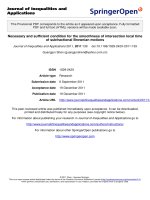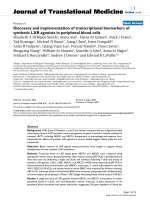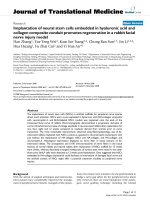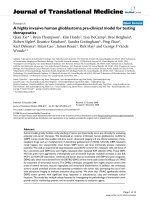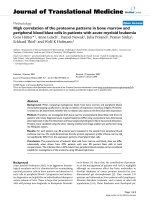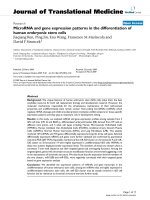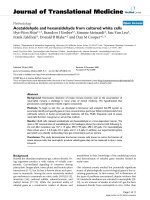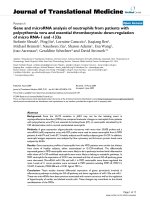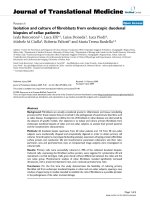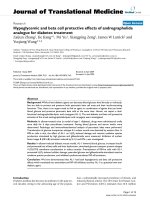Báo cáo hóa học: " Cutaneous and mucosal human papillomaviruses differ in net surface charge, potential impact on tropism" pptx
Bạn đang xem bản rút gọn của tài liệu. Xem và tải ngay bản đầy đủ của tài liệu tại đây (717.42 KB, 6 trang )
BioMed Central
Page 1 of 6
(page number not for citation purposes)
Virology Journal
Open Access
Short report
Cutaneous and mucosal human papillomaviruses differ in net
surface charge, potential impact on tropism
Nitesh Mistry, Carl Wibom and Magnus Evander*
Address: Department of Virology, Umeå University, SE-901 85, Umeå, Sweden
Email: Nitesh Mistry - ; Carl Wibom - ; Magnus Evander* -
* Corresponding author
Abstract
Papillomaviruses can roughly be divided into two tropism groups, those infecting the skin, including
the genus beta PVs, and those infecting the mucosa, predominantly genus alpha PVs. The L1 capsid
protein determines the phylogenetic separation between beta types and alpha types and the L1
protein is most probably responsible for the first interaction with the cell surface. Virus entry is a
known determinant for tissue tropism and to study if interactions of the viral capsid with the cell
surface could affect HPV tropism, the net surface charge of the HPV L1 capsid proteins was
analyzed and HPV-16 (alpha) and HPV-5 (beta) with a mucosal and cutaneous tropism respectively
were used to study heparin inhibition of uptake. The negatively charged L1 proteins were all found
among HPVs with cutaneous tropism from the beta- and gamma-PV genus, while all alpha HPVs
were positively charged at pH 7.4. The linear sequence of the HPV-5 L1 capsid protein had a
predicted isoelectric point (pI) of 6.59 and a charge of -2.74 at pH 7.4, while HPV-16 had a pI of
7.95 with a charge of +2.98, suggesting no interaction between HPV-5 and the highly negative
charged heparin. Furthermore, 3D-modelling indicated that HPV-5 L1 exposed more negatively
charged amino acids than HPV-16. Uptake of HPV-5 (beta) and HPV-16 (alpha) was studied in vitro
by using a pseudovirus (PsV) assay. Uptake of HPV-5 PsV was not inhibited by heparin in C33A cells
and only minor inhibition was detected in HaCaT cells. HPV-16 PsV uptake was significantly more
inhibited by heparin in both cells and completely blocked in C33A cells.
Findings
Papillomavirus (PV) belongs to the Papillomaviridae fam-
ily and consists of a large family of non-enveloped double
stranded DNA viruses that infect the basal layer of cutane-
ous or mucosal epithelia of a dozen vertebrate species
with a strict species tropism [1]. Over 100 human papillo-
mavirus (HPV) types have been completely described and
identified in human tissues and they together with animal
PVs are divided into 16 genera based on their nucleotide
sequence identity of the major capsid protein L1 open
reading frame (ORF) [2]. HPVs can roughly be divided
into two tropism groups, those infecting the skin, includ-
ing the genus beta PVs, and those infecting the mucosa,
predominantly genus alpha PVs.
The first step of PV infection is binding of the major capsid
protein L1 to the cell surface. The cell surface gly-
cosaminoglycan (GAG) heparan sulfate (HS) is important
for HPV infection in vitro of several HPV types from the
alpha genus [3-7]. HS contains highly sulphated repeats
of disaccharides and is highly negatively charged. Other
receptors than HS may function at a later entry step and
Published: 14 October 2008
Virology Journal 2008, 5:118 doi:10.1186/1743-422X-5-118
Received: 14 September 2008
Accepted: 14 October 2008
This article is available from: />© 2008 Mistry et al; licensee BioMed Central Ltd.
This is an Open Access article distributed under the terms of the Creative Commons Attribution License ( />),
which permits unrestricted use, distribution, and reproduction in any medium, provided the original work is properly cited.
Virology Journal 2008, 5:118 />Page 2 of 6
(page number not for citation purposes)
α6-integrin has been suggested as a candidate receptor [8].
Furthermore, PVs has been shown to bind to a basal extra-
cellular matrix component that co-localizes with laminin-
5 within the basal extracellular matrix [9-11]. Since the
sequence of the L1 capsid protein determines the phyloge-
netic separation between beta types and alpha types [2]
and the L1 protein is most probably responsible for the
first interaction with the cell surface, one can suspect that
the interactions of the viral capsid with the cell surface
could affect HPV tropism. To study this, the net surface
charge of the HPV L1 capsid proteins was analyzed and
HPV-16 (alpha) and HPV-5 (beta) with a mucosal and
cutaneous tropism respectively, were used to study
heparin inhibition of uptake.
The predicted isoelectric point (pI) of the receptor binding
L1 capsid for all available HPV types was examined and
found to correlate with the cutaneous or mucosal tropism
(Table 1). The pI calculations were based solely on protein
sequence and the charge of exposed epitopes of L1 were
not calculated. Interestingly, the negatively charged L1
proteins were all found among HPVs with cutaneous tro-
pism from the beta- and gamma-PV genus (Table 1). The
pI was almost identical for HPV types within the same
species. HPV-5 had a pI of 6.59 and a negative charge of -
2.74 at pH 7.4. In comparison the alpha HPV-16, which
interacts with the negatively charged heparan sulfate, had
a pI of 7.95 and a +2.98 positive charge at pH 7.4. In fact
all alpha HPVs from the alpha-PV genus were positively
charged at pH 7.4 (Table 1). The exception was HPV-2 and
HPV-27 from the alpha-PV genus species 4, but they have
been detected both in cutaneous and mucosal lesions [2].
The interaction of HPV with HS seems to depend on
charge distribution since replacement of three surface-
exposed lysine residues for alanine in the HPV-16 L1 cap-
sid protein resulted in reduced cell binding and infectivity
of HPV-16 PsV [12]. The authors suggested that these
lysine residues cooperate in a charge-dependent HS bind-
ing, facilitation HPV-16 PsV infection [12]. These residues
are conserved among alpha-PVs, but are not found in the
beta HPVs.
A 3D-model of the L1 protein monomer of the alpha
HPV-16 and the beta HPV-5 was generated by using the
structure file for the HPV-16 L1 monomer [13] to visual-
ize the number of exposed charged amino acids on L1
protein. The 3D-model showed that each HPV-5 L1 mon-
omer contained 4 amino acids with a positive charge and
9 with a negative charge on the different loops. HPV-16 L1
had 6 positive and only 3 negative charged amino acids
exposed on its surface (Figure 1). The invading arms were
also studied and showed only a small difference in
exposed charged amino acids. HPV-5 had 10 positive and
12 negative amino acids whereas HPV-16 had 11 positive
and 8 negatively charged amino acids on the part of the
invading arm exposed to the surface (data not shown).
Given that there are 360 L1 monomers to build up a HPV
capsid these result implied that HPV-5 was more nega-
tively charged than HPV-16. The HPV-5 L1 monomer was
generated using the HPV-16 L1 monomer as a template,
and therefore these calculations needs to be further
addressed when more PV capsids have been crystallized to
fully evaluate the epitopes.
The difference in theoretical net surface charge between
the L1 protein of alpha and beta PVs prompted an analysis
of dependence of charged receptor structures for virus
uptake into cells.
Heparin is highly negatively charged and was used for
inhibition studies of alpha HPV-16 and beta HPV-5 pseu-
dovirus (PsV) uptake, analyzed by expression of the GFP
marker gene [14,15]. GFP-expressing PsV were produced
according to established methods [16]. Briefly, plasmids
expressing the codon-modified papillomavirus major and
minor capsid proteins, L1 and L2, together with a green
fluorescent protein (GFP) expressing reporter plasmid,
were transfected into 293TT cells. Capsids were allowed to
mature overnight in cell lysate and were then purified
using OptiPrep
®
gradients (Axis-Shield). Plasmids and
293TT cells used for pseudovirus production were a kind
gift from Chris Buck (NCI, Bethesda, Maryland, USA) and
Martin Müller (German Cancer Research Center, Heidel-
berg, Germany). Detailed protocols are available at the
website />. The
human epithelial cell line HaCaT, from adult trunk skin
[17] and the human cervical cell line C33A [18] were
plated at 5 × 10
4
cells/well in 24-well plates. PsV doses
were calibrated according to [19] and before addition to
the cells, PsV were incubated with various concentrations
of heparin (Sigma Chemical Co.) for 60 min on ice in
DMEM with 10% FCS. The PsV and heparin solution were
then added to cells for 44–52 h at 37°C and fluorescence
was quantified by flow cytometry [19]. There was no sig-
nificant heparin inhibition of HPV-5 PsV uptake in cervi-
cal C33A cells and only a small inhibitory effect of
heparin on HPV-5 PsV mediated GFP expression was
noted in cutaneous HaCaT cells. Uptake of HPV-16 PsV
mediated GFP expression was completely inhibited in
C33A cells at 30 μg/ml of heparin (IC
50
= 15.5 μg/ml) and
it was also dose-dependent (IC
50
= 24.5 μg/ml) with a
maximum inhibition level of 72% in HaCaT cells. The dif-
ference in inhibition between HPV-5 and HPV-16 was sig-
nificant (using a 2-tailed student T-test) both in C33A
cells (P < 0.0004) and in HaCaT cells (P < 0.03).
In summary, beta HPV-5 PsV uptake was not inhibited in
C33A cells and there was only a minor inhibition detected
in HaCaT cells similar to previous results where HPV-5
Virology Journal 2008, 5:118 />Page 3 of 6
(page number not for citation purposes)
Table 1: Predicted values for pI and charge at pH 7.4 for HPV L1.
Genus Species Infected region HPV type pI-value Charge at pH 7.4
Alpha-papillomavirus 1 Mucosa 32 8.38 5.2
2 Cutaneous (Mucosa) 10 7.65 1.02
3Mucosa 61 8.24.88
4 Cutaneous (Mucosa) 2 6.87 -1.8
5 Mucosa 26 8.38 5.24
6 Mucosa 53 8.59 6.3
7 Mucosa 18 8.35 7.85
8 Mucosa (Cutaneous) 7 7.46 0.2
9 Mucosa 16 7.95 2.98
10 Mucosa 6 8.55 7.08
11 Mucosa 34 8.3 6.68
13 Mucosa 54 8.5 6.15
Beta-papillomavirus 1 Cutaneous 5 6.59 -2.74
2 Cutaneous 9 5.88 -6.76
3 Cutaneous 49 6.01 -4.94
Gamma-papillomavirus 1 Cutaneous 4 6.34 -4.43
2 Cutaneous 48 5.57 -7.53
3 Cutaneous 50 6.02 -5.57
4 Cutaneous 60 7.14 -0.71
Mu-papillomavirus 1 Cutaneous 1 6.63 -1.54
2 Cutaneous 63 6.56 -2.43
Nu-papillomavirus 1 Cutaneous 41 6.13 -6.71
The HPV types displayed are the HPV type species according to[2]. The other HPVs in the species had similar pI as the type species (data not
shown). The theoretical isoelectric point (pI) calculations in this study were based solely on protein sequence and did not take 3D-aspects or
residue-residue interactions into consideration. To attain a prediction of the pI of the protein the theoretical charge was calculated at every pH
between 1 and 13, with an increment of 0.01. The pH with the total charge closest to zero was used as the pI of the protein. The theoretical charge
of a sequence at any given pH was determined by the frequency of a few amino acids. Lysine, arginine, histidine and the N-terminal residue
contributed positively to the over all charge of a sequence, whereas aspartic acid, glutamic acid, cysteine, tyrosine as well as the C-terminal residue
contributed negatively. All other types of amino acids were for this purpose considered neutral. To attain the overall charge of the protein, the
total contributing charge for each of the positive amino acids was summarized and the total contributing charge for all negative amino acids was
subtracted />. The pKa-constants we employed for our calculations were kindly
shared to us by the European Molecular Biology Laboratory.
Virology Journal 2008, 5:118 />Page 4 of 6
(page number not for citation purposes)
Comparison of surface exposed charge differences of HPV-5 and HPV-16 L1 capsid proteinsFigure 1
Comparison of surface exposed charge differences of HPV-5 and HPV-16 L1 capsid proteins. The model of the
HPV-5 L1 monomer is overlaid on the crystal structure of HPV-16 L1. Colour in this illustration display positive (blue) and neg-
ative (red) amino acids loops of L1. To model L1 capsid protein the structure file for the HPV-16 L1 monomer, 1 DZL.pdb
[13], was downloaded and used as a template to model L1-monomers for HPV-5 using SWISS MODEL http://swiss-
model.expasy.org//SWISS-MODEL.html. Protein models were also ray-traced using POV-Ray The 3D-
models of L1 protein of an alpha-papillomavirus (HPV-16) and a beta-papillomavirus (HPV-5) visualize the number of charged
amino acids on one L1 capsid protein that are more than 30% exposed in the surface when grouped into a pentamer.
Virology Journal 2008, 5:118 />Page 5 of 6
(page number not for citation purposes)
pseudovirus infection of HeLa cells was not inhibited by
heparin [20]. Alpha HPV-16 was significantly more inhib-
ited by heparin in both cells and completely blocked in
C33A cells, similar to another alpha-PV, HPV-31b, where
infection in C33A cells was clearly dependent on heparan
sulfate, while pre-treatment with heparin only had a small
inhibitory effect of infection in HaCaT cells [21].
In a study comparing HS expression in skin and mucosa,
more GAGs were found in vaginal tissue than in perianal
skin, although this difference could possibly be explained
by differential expression of chondroitin sulfates and der-
matan sulfate and not HS [22]. Both the extracellular
matrix in addition to the cell surface and the epithelial
basement membrane seems to be the primary site of virus
binding during genital tract infection in vivo [23] and a
dynamic model for alpha-HPV entry has been suggested
where binding of alpha HPV to cell surface HS results in
conformational change in the capsid, followed by binding
to a second receptor [24]. This second receptor is sug-
gested to be a non-HS receptor [25] and is most probably
L1-specific [24]. Tropism could also be determined at
another step in the infectious cycle and the long control
region (LCR) of HPV DNA, which contains binding sites
for transcription factors and numerous binding sites for
epithelial specific enhancers has been studied for a role in
HPV tropism[26]. In HaCaT cells, the HPV-5 LCR was
two-fold more efficient in transcriptional activation com-
pared to the HPV-16 LCR, while in cervical W12E cells the
HPV-16 LCR was almost 2-fold more effective in activat-
ing transcription compared to the HPV-5 LCR [27].
To conclude, the first step of a virus infection is attach-
ment to the cell surface and net charge is important for
determining virus binding to cell receptors, as has been
shown for certain adenoviruses [28]. The observed differ-
ences between HPV-5 and HPV-16 could be of importance
for PV tropism, but extended studies with more HPV
types, including the possible second receptors have to be
performed.
Competing interests
The authors declare that they have no competing interests.
Authors' contributions
NM participated in the design of the study, carried out
virus infection experiments, 3D modelling and drafted the
manuscript. CW carried out calculation of theoretical pI
and 3D modelling experiments. ME conceived the study,
participated in its design and coordination and helped to
draft the manuscript. All authors read and approved the
final manuscript.
Acknowledgements
We thank Chris Buck and Martin Müller for pseudoviruses. Our work was
supported by grants from the Lions Research Foundation, Umeå University,
the Umeå University Medical Research Foundation, the Magn. Bergvall
Foundation and the Kempe Foundation, Sweden.
References
1. zur Hausen H: Papillomaviruses and cancer: from basic studies
to clinical application. Nat Rev Cancer 2002, 2(5):342-350.
2. de Villiers EM, Fauquet C, Broker TR, Bernard HU, zur Hausen H:
Classification of papillomaviruses. Virology 2004, 324(1):17-27.
3. Combita AL, Touze A, Bousarghin L, Sizaret PY, Munoz N, Coursaget
P: Gene transfer using human papillomavirus pseudovirions
varies according to virus genotype and requires cell surface
heparan sulfate. FEMS Microbiol Lett 2001, 204(1):183-188.
4. Drobni P, Mistry N, McMillan N, Evander M: Carboxy-fluorescein
diacetate, succinimidyl ester labeled papillomavirus virus-
like particles fluoresce after internalization and interact with
heparan sulfate for binding and entry. Virology 2003,
310(1):163-172.
5. Giroglou T, Florin L, Schafer F, Streeck RE, Sapp M: Human papil-
lomavirus infection requires cell surface heparan sulfate. J
Virol 2001, 75(3):1565-1570.
6. Joyce JG, Tung JS, Przysiecki CT, Cook JC, Lehman ED, Sands JA,
Jansen KU, Keller PM: The L1 major capsid protein of human
papillomavirus type 11 recombinant virus-like particles
interacts with heparin and cell-surface glycosaminoglycans
on human keratinocytes. J Biol Chem 1999, 274(9):5810-5822.
7. Shafti-Keramat S, Handisurya A, Kriehuber E, Meneguzzi G, Slupetzky
K, Kirnbauer R: Different heparan sulfate proteoglycans serve
as cellular receptors for human papillomaviruses. J Virol 2003,
77(24):13125-13135.
8. Evander M, Frazer IH, Payne E, Qi YM, Hengst K, McMillan NA: Iden-
tification of the alpha6 integrin as a candidate receptor for
papillomaviruses. J Virol 1997, 71(3):2449-2456.
9. Culp TD, Budgeon LR, Christensen ND: Human papillomaviruses
bind a basal extracellular matrix component secreted by
keratinocytes which is distinct from a membrane-associated
receptor. Virology 2006, 347(1):147-159.
10. Culp TD, Budgeon LR, Marinkovich MP, Meneguzzi G, Christensen
ND: Keratinocyte-secreted laminin 5 can function as a tran-
sient receptor for human papillomaviruses by binding virions
and transferring them to adjacent cells. J Virol 2006,
80(18):8940-8950.
11. Day PM, Thompson CD, Buck CB, Pang YY, Lowy DR, Schiller JT:
Neutralization of human papillomavirus with monoclonal
antibodies reveals different mechanisms of inhibition. J Virol
2007, 81(16):8784-8792.
12. Knappe M, Bodevin S, Selinka HC, Spillmann D, Streeck RE, Chen XS,
Lindahl U, Sapp M: Surface-exposed amino acid residues of
HPV16 L1 protein mediating interaction with cell surface
heparan sulfate. J Biol Chem 2007, 282(38):27913-27922.
13. Chen XS, Garcea RL, Goldberg I, Casini G, Harrison SC: Structure
of small virus-like particles assembled from the L1 protein of
human papillomavirus 16. Mol Cell 2000, 5(3):557-567.
14. Buck CB, Pastrana DV, Lowy DR, Schiller JT: Efficient intracellular
assembly of papillomaviral vectors. J Virol 2004, 78(2):751-757.
15. Pyeon D, Lambert PF, Ahlquist P: Production of infectious human
papillomavirus independently of viral replication and epithe-
lial cell differentiation. Proc Natl Acad Sci USA 2005,
102(26):9311-9316.
16. Buck CB, Pastrana DV, Lowy DR, Schiller JT: Generation of HPV
pseudovirions using transfection and their use in neutraliza-
tion assays. Methods Mol Med 2005, 119:445-462.
17. Boukamp P, Petrussevska RT, Breitkreutz D, Hornung J, Markham A,
Fusenig NE: Normal keratinization in a spontaneously immor-
talized aneuploid human keratinocyte cell line. J Cell Biol 1988,
106(3):761-771.
18. Crook T, Wrede D, Vousden KH: p53 point mutation in HPV
negative human cervical carcinoma cell lines. Oncogene 1991,
6(5):873-875.
19. Mistry N, Drobni P, Naslund J, Sunkari VG, Jenssen H, Evander M:
The anti-papillomavirus activity of human and bovine lactof-
erricin. Antiviral Res 2007, 75(3):258-265.
20. Buck CB, Thompson CD, Roberts JN, Muller M, Lowy DR, Schiller JT:
Carrageenan is a potent inhibitor of papillomavirus infec-
tion. PLoS Pathog 2006, 2(7):e69.
Publish with BioMed Central and every
scientist can read your work free of charge
"BioMed Central will be the most significant development for
disseminating the results of biomedical research in our lifetime."
Sir Paul Nurse, Cancer Research UK
Your research papers will be:
available free of charge to the entire biomedical community
peer reviewed and published immediately upon acceptance
cited in PubMed and archived on PubMed Central
yours — you keep the copyright
Submit your manuscript here:
/>BioMedcentral
Virology Journal 2008, 5:118 />Page 6 of 6
(page number not for citation purposes)
21. Patterson NA, Smith JL, Ozbun MA: Human papillomavirus type
31b infection of human keratinocytes does not require
heparan sulfate. J Virol 2005, 79(11):6838-6847.
22. Bezerra LR, Feldner PC Jr, Kati LM, Girao MJ, Sartori MG, Baracat EC,
de Lima GR, Nader HB, Dietrich CP: Sulfated glycosaminogly-
cans of the vagina and perineal skin in pre- and postmeno-
pausal women, according to genital prolapse stage. Int
Urogynecol J Pelvic Floor Dysfunct 2004, 15(4):266-271.
23. Roberts JN, Buck CB, Thompson CD, Kines R, Bernardo M, Choyke
PL, Lowy DR, Schiller JT: Genital transmission of HPV in a
mouse model is potentiated by nonoxynol-9 and inhibited by
carrageenan. Nat Med 2007, 13(7):857-861.
24. Day PM, Gambhira R, Roden RB, Lowy DR, Schiller JT: Mechanisms
of human papillomavirus type 16 neutralization by l2 cross-
neutralizing and l1 type-specific antibodies. J Virol 2008,
82(9):4638-4646.
25. Selinka HC, Florin L, Patel HD, Freitag K, Schmidtke M, Makarov VA,
Sapp M: Inhibition of transfer to secondary receptors by
heparan sulfate-binding drug or antibody induces noninfec-
tious uptake of human papillomavirus. J Virol 2007,
81(20):10970-10980.
26. O'Conner M, Chan SY, Bernard HU: Transcription Factor Bind-
ing Sites in the Long Control Region of Genital HPVs. In
Human papillomaviruses, 1995 compendium Volume part III. Edited by: B
HU, G Meyers HD, Baker C, Icenogle J, Halpern A, and Wheeler C.
Los Alamos National Laboratory, Los Alamos, N. Mex; 1995:21-40.
27. Mistry N, Simonsson M, Evander M: Transcriptional activation of
the human papillomavirus type 5 and 16 long control region
in cells from cutaneous and mucosal origin. Virol J 2007, 4:27.
28. Arnberg N, Kidd AH, Edlund K, Nilsson J, Pring-Akerblom P, Wadell
G: Adenovirus type 37 binds to cell surface sialic acid through
a charge-dependent interaction. Virology 2002, 302(1):33-43.
